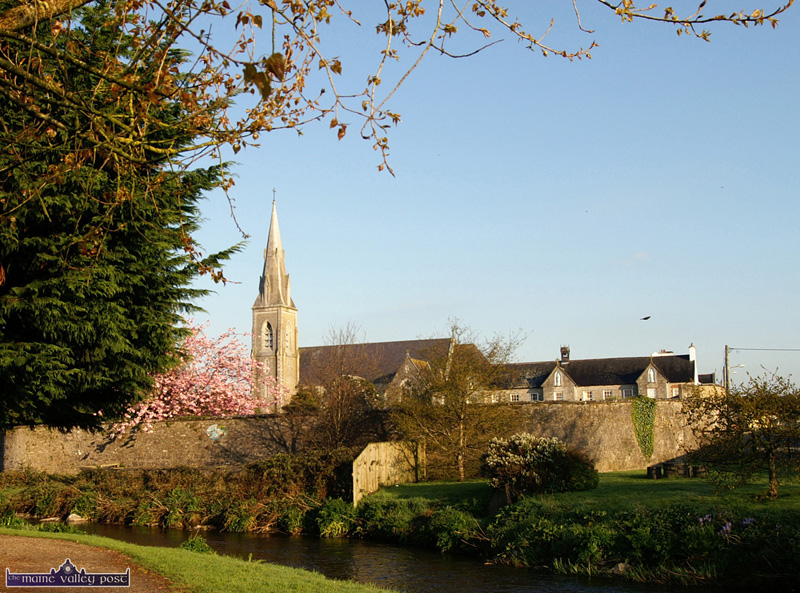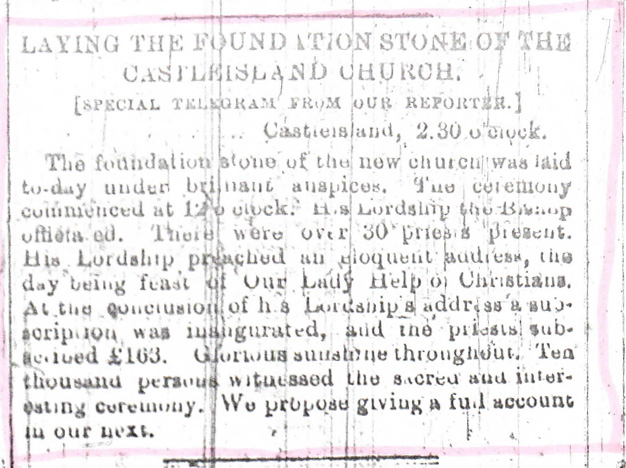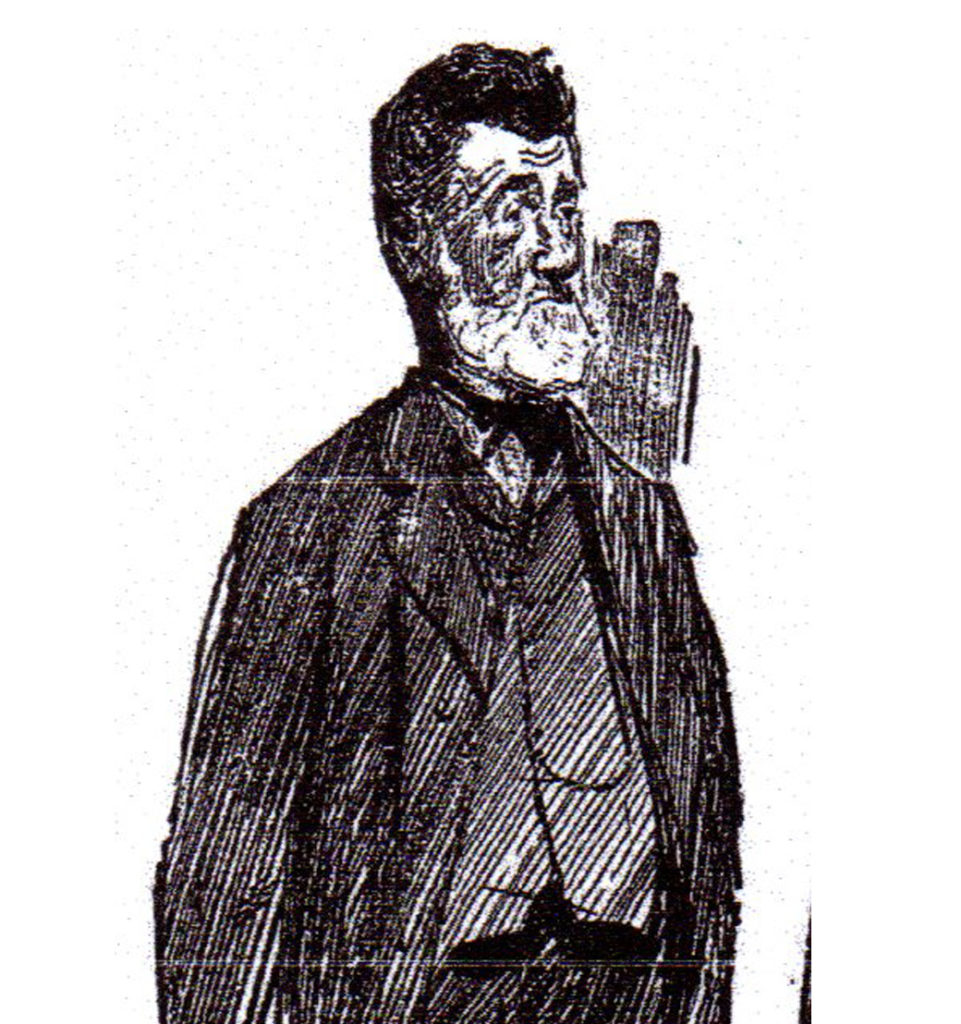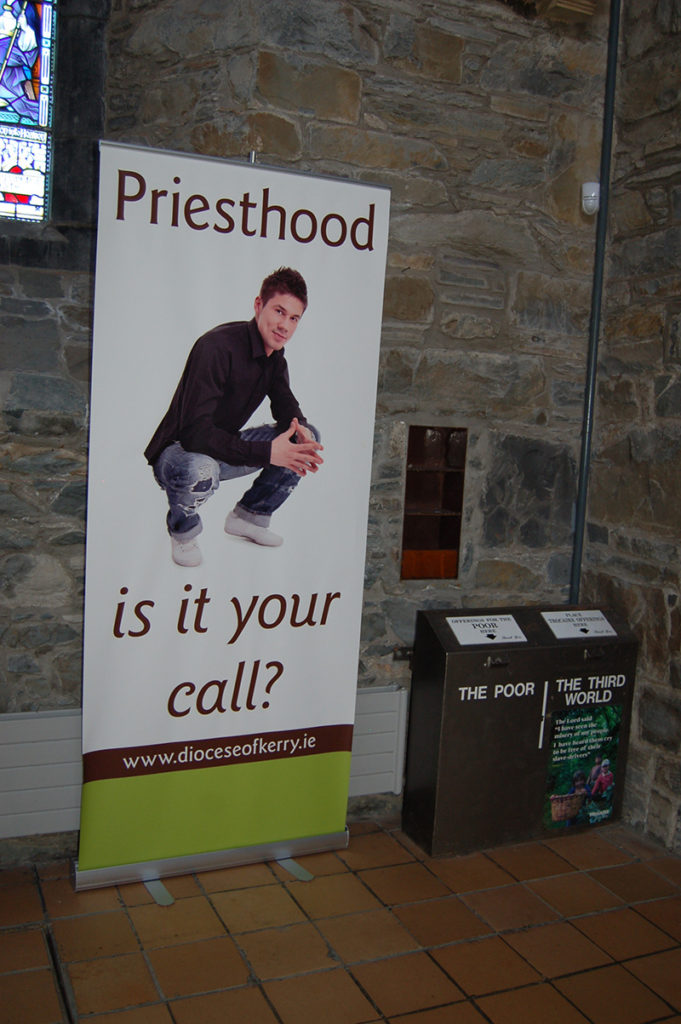The Michael O’Donohoe archive contains a study of Castleisland parish church, Church of St Stephen and St John.

In 1878, Most Rev Dr M’Carthy, Bishop of Kerry, spoke of the ‘great want’ of a parochial church in Castleisland during a visitation there.1
The church that then existed was described as ‘very seedy looking’ and stood ‘quite adjacent’ to the site of the new church.2
The foundation stone was laid on the feast of Our Lady Help of Christians (24 May) 1881, a day of ‘glorious sunshine’. A special telegram of the occasion revealed that over 30 priests were present and ten thousand persons witnessed the ceremony.3

Some two and a half years later, when the church was ‘rapidly approaching completion’, a disinterment ceremony took place to ‘transfer the remains of the deceased priests of the parish from their resting place in the old chapel to graves prepared for them in one of the aisles of the new church’:
The remains were placed in new coffins on a catafalque before the altar in the old chapel and everything that the most pious care for the sacred remains could suggest or that could confer solemnity on the occasion having been scrupulously attended to, High Mass for the repose of the souls of the deceased priests was celebrated.
A procession was formed, which included ‘schoolchildren with lighted tapers’, to accompany the ‘one pall and one bier … all that the destroying hand of Time had left of them’ in its journey to the new church where it was placed beneath the dome of ‘that most beautiful edifice’.4
By 8 September 1884, the new church was open, as evidenced by P D Kenny of Ballymacadam, who described how he went into the new church on Fair Day, 8 September 1884 where he met the Lord Lieutenant.5

Official Opening Ceremony
The official opening ceremony took place on 5 October 1884. A report of the event included a lengthy description of the architecture including artefacts cut from ‘Castleisland red marble’ and the church organ, built by Thomas W Magahy of Cork, who was awarded a first prize medal at the Cork Exhibition of 1883.6
Rev Father Naughton, SJ, preached during the ceremony. He spoke of how ‘God alone knew what Ireland suffered’ and how ‘Ireland’s faith had passed the ordeal of persecution’. The only trial not yet undergone, he said, was ‘the test of prosperity and a little liberty’ which was ‘Ireland’s last and greatest danger’:
How would she come through it. Faithful to God in the days of persecution, would she continue so in the day of her resurrection, or intoxicated with a little wealth and a little manly liberty that she is not used to, will she find that her strength is gone and that she is weak like other nations.7

Church History
Papers relating to church history are also included in this series. One document contains reference to eight Lenten Regulations signed by ANDREW, Bishop of Kerry in 1881. Rule 5 stipulates:
Lard and dripping may be used as a condiment in dressing fish, herbs, &c, on all days on which butter is allowed.
An interesting article, ‘The Priests of Kerry Two Hundred Years Ago’ provides a list of parish priests registered in the year 1704. Thirty-six names were returned for Kerry, many of whom had received Holy Orders in France, and Michael O’Donohoe highlighted those from parishes in the Castleisland district.
The document, which can be read here (Parish Priests 1704), includes Morris Cahane of Killcarrigbegg, having as his parishes ‘Duagh and Broshnagh’; Edmond Hogan of Magh, having as his parishes ‘BallymacElligott, Nohovall, O’Brianin and Ballysheeda’; Charles Deorane of Ballyplimoth, having as his parishes ‘Ballincushlane and Castleisland’; Teige Daily of Reghnelogh having as his parishes ‘Currens, Killenterna and Disart’ and Charles Daily of Droumuoltane having as his parishes ‘Castleisland and Ballynacashland’.8
________________________________
1 IE MOD/57/57.2/57.2.1, 'The Most Rev Dr M’Carthy in Castleisland'. Alludes to the ongoing church building fund 'of many years' duration. 2 IE MOD/57/57.2/57.2.4. 'One wing had to be removed in order to make room for the ground-plan of the new'. 3 IE MOD/57/57.2/57.2.2. See also IE MOD 57/57.2/57.2.3, 'The New Church at Castleisland' dated May 1881. 4 IE MOD/57/57.2/57.2.6 5 IE MOD/57/57.2/57.2.7. P D Kenny had written to the editor of the Kerry Sentinel (issue of 30 September 1884) berating his treatment under the Coercion Act, 'I believe I am right in saying that I was the first man in the South of Ireland arrested under that infamous Act'. Letter describes how he was approached by the Lord Lieutenant in the new church. Further reference to P D Kenny IE MOD/78. See also IE MOD/57/57.2/57.2.5, 'The Most Rev Dr Higgins in Castleisland' in which the Lord Bishop spoke in Castleisland in July 1882 on 'the state of the Country'. 6 'The death occurred yesterday with tragic suddenness of Mr Thomas Walter Magahy, Ivy Lawn, Evergreen Road, Cork. Mr Magahy was aged 75. The late Mr Magahy was proprietor of the well known Cork firm of T W Magahy and Sons, Merchant Street, organ builders and organ repairers since 1870 when the business was established by Mr Magahy's father'. Obituary in full, Irish Examiner, 18 January 1957. 7 'Dedication of the New Church at Castleisland', Kerry Weekly Reporter, 11 October 1884. The following week, the sudden death of Father Maurice Herlihy, curate of the parish, at the early age of 42 brought sorrow to the community. See IE MOD 57/57.2/57.2.8. 8 IE MOD/57/57.2/57.2.11. Article published in Kerry Sentinel 24 October 1891 and relates to a register published by the Queen's Printer, Andrew Crook, "on the Blind Key, 1705" held at the British Museum, entitled A List of the Names of the Popish Parish Priests as they were registered at a General Sessions of the Peace held for the said county at _____ , the 11th day of July 1704 and were since returned up to the Council Office in Dublin, pursuant to a clause in the late Act of Parliament intituled An Act for Registering the Popish Clergy. Further reference see The Irish Priests in the Penal Times (1660-1760) (1914) by Rev William P Burke.


